Philippe Dufour Simplicity Reviewed by Tim Mosso: Photofest!
by Tim Mosso
Above all, Philippe Dufour is a gentleman. I know this because I met him, and he spoke to me – on camera, no less – when many less august figures in the industry wouldn’t spare a moment for an aftermarket character like myself.
Dufour is the master watchmaker you imagine. He’s scholarly, accomplished, revered, an eminence grise of the watch universe, and the guy all the up-and-coming craftsmen want to be.
Philippe Dufour is also full of surprises, approachable, and a pleasure to encounter – just like his sold-out-forever watch, the Simplicity.
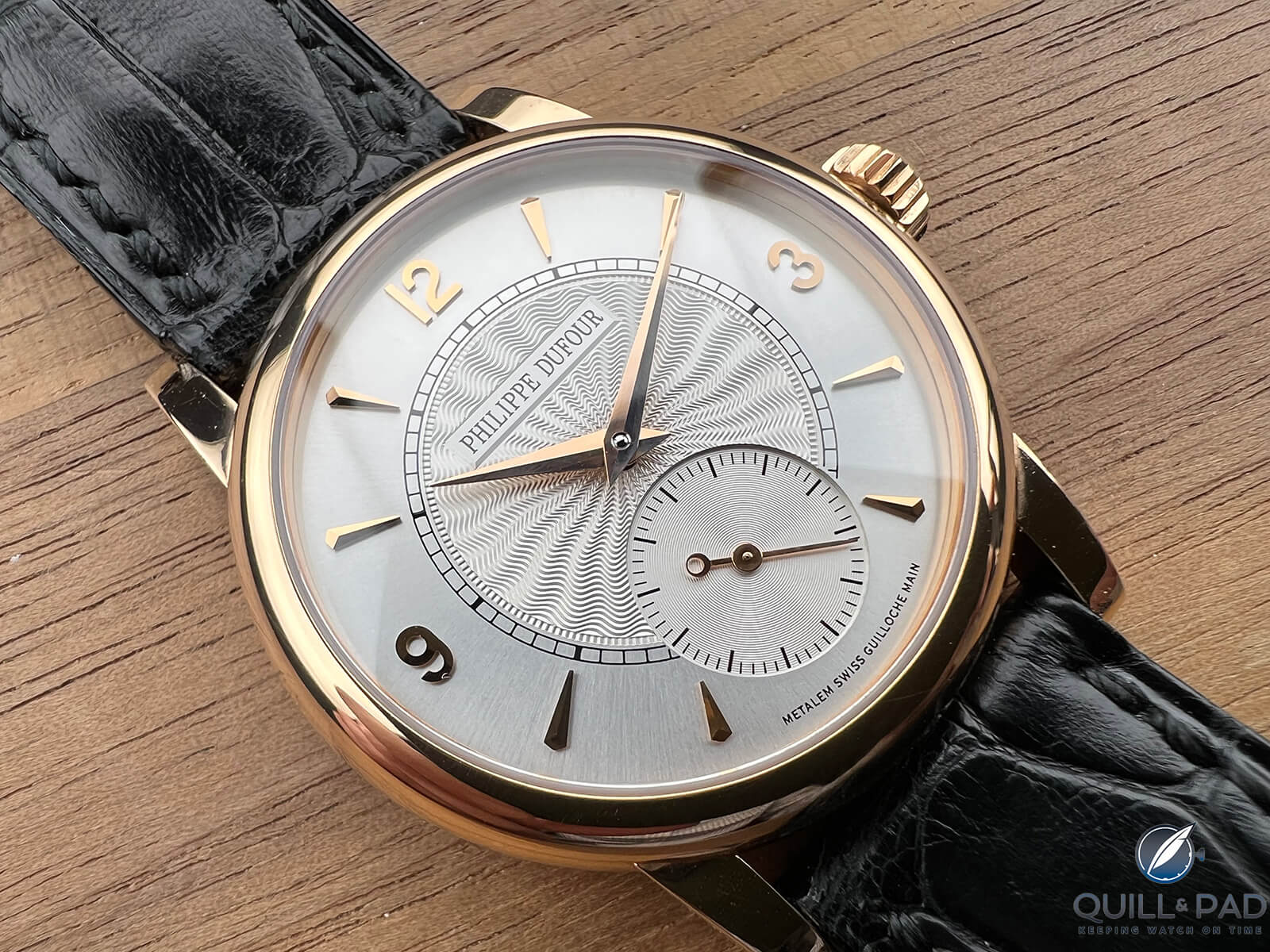
Philippe Dufour Simplicity (photo by Tim Mosso)
The irony of the Simplicity is that it arrived on the tail end of a period in which Dufour created grande sonnerie pocket watches, the first wristwatch grande et petite sonnerie, and the cerebral Duality. The Simplicity’s predecessors were feats of miniaturization in which massive complexity was cloaked in reasonably sized packaging.
Following a career that spanned Jaeger-LeCoultre, Gérald Genta, Audemars Piguet, and two decades as an independent complication specialist par excellence, Dufour decided to stake his long-term future on a basic-but-beautiful watch like the types he restored in his earlier years.
The Simplicity, launched in 2000, was likely Dufour’s most serious venture into uncomplicated watchmaking since his formative days as a watchmaker. When I spoke with him at Dubai Watch Week in 2019, he mentioned that the Simplicity was envisioned as a targeted release for the Japanese market.
Late 1990s style conventions and the predilections of Dufour’s anticipated audience led to case options that seem almost quaint from the vantage point of 2023.
While a 37mm – the “jumbo,” I guess – was available, the watch featured in this study is the 34mm variant.
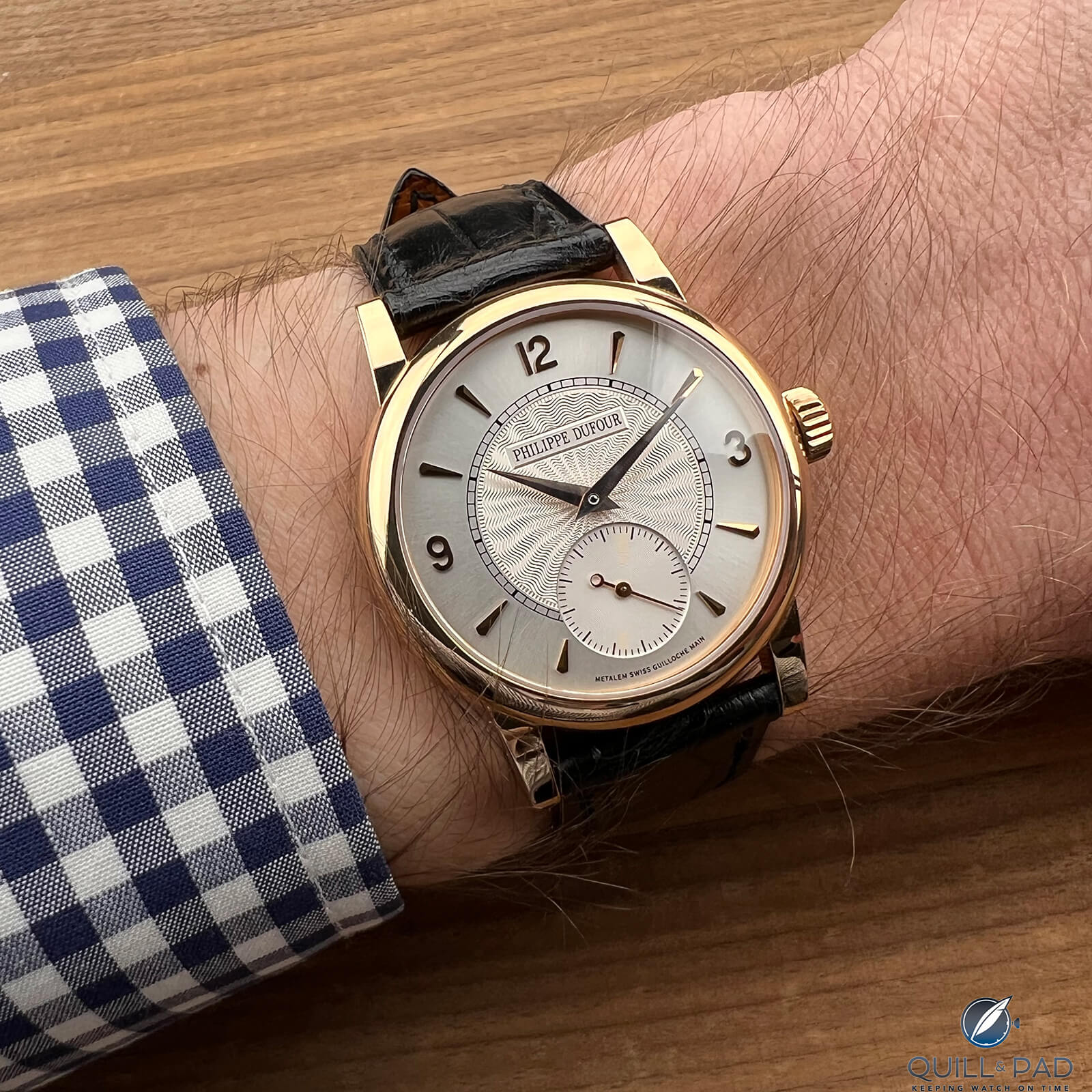
Philippe Dufour Simplicity (photo by Tim Mosso)
Perhaps it’s the strong lug profiles, or maybe it’s the sheer awe inherent in the experience, but the 34mm Simplicity feels like plenty of watch. My 16cm circumference wrist provides the hand model for the images in this study, and I never felt like the rose gold micro machine needed more bulk.
There was a time – admittedly, receding to the trailing edge of living memory – when 32-34mm dress watches were not only accepted but expected among men of taste.
Some of my European colleagues have advised that watches are to be avoided in black tie attire, but if there’s any watch that would look at home with a tux, it’s the Simplicity. It’s elegance incarnate.
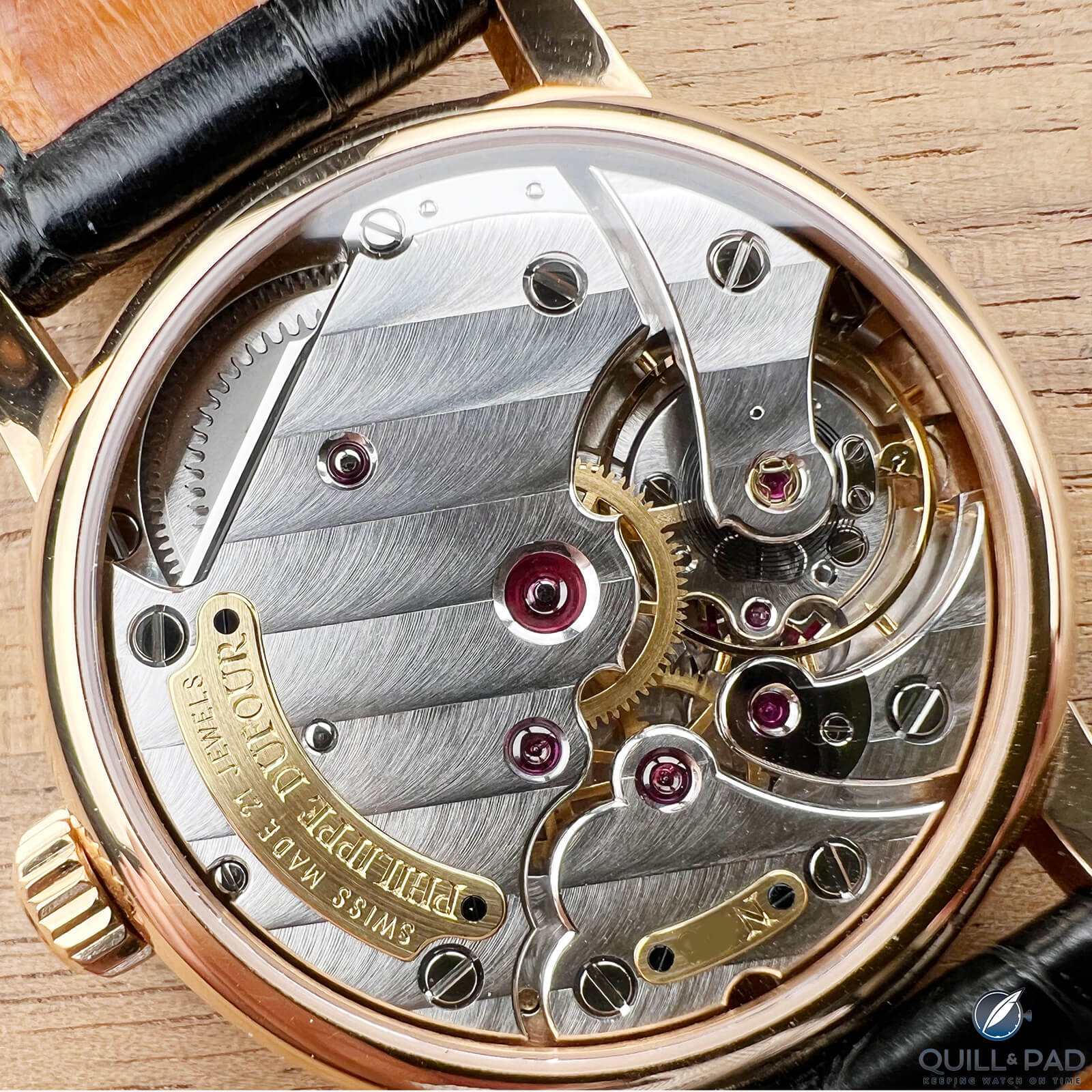
Philippe Dufour Simplicity movement (photo by Tim Mosso)
The caseback of the Simplicity is a thunderous broadside worthy of H.M.S. Victory. Mechanically, there’s nothing here that you can’t find on a sub-$5,000 watch, but the execution is its reason for being.
Côtes de Genève (aka Geneva waves) are the stripes – often perfunctory – that are found on most movement executions. The cheapest are stamped. Better stripes are laid down by some kind of abrasive but narrowly and in quick fashion. The best stripes are broad, lustrous, deeply grooved like the barbs of a feather, and exhibit a colossal shading gradience across their surfaces.
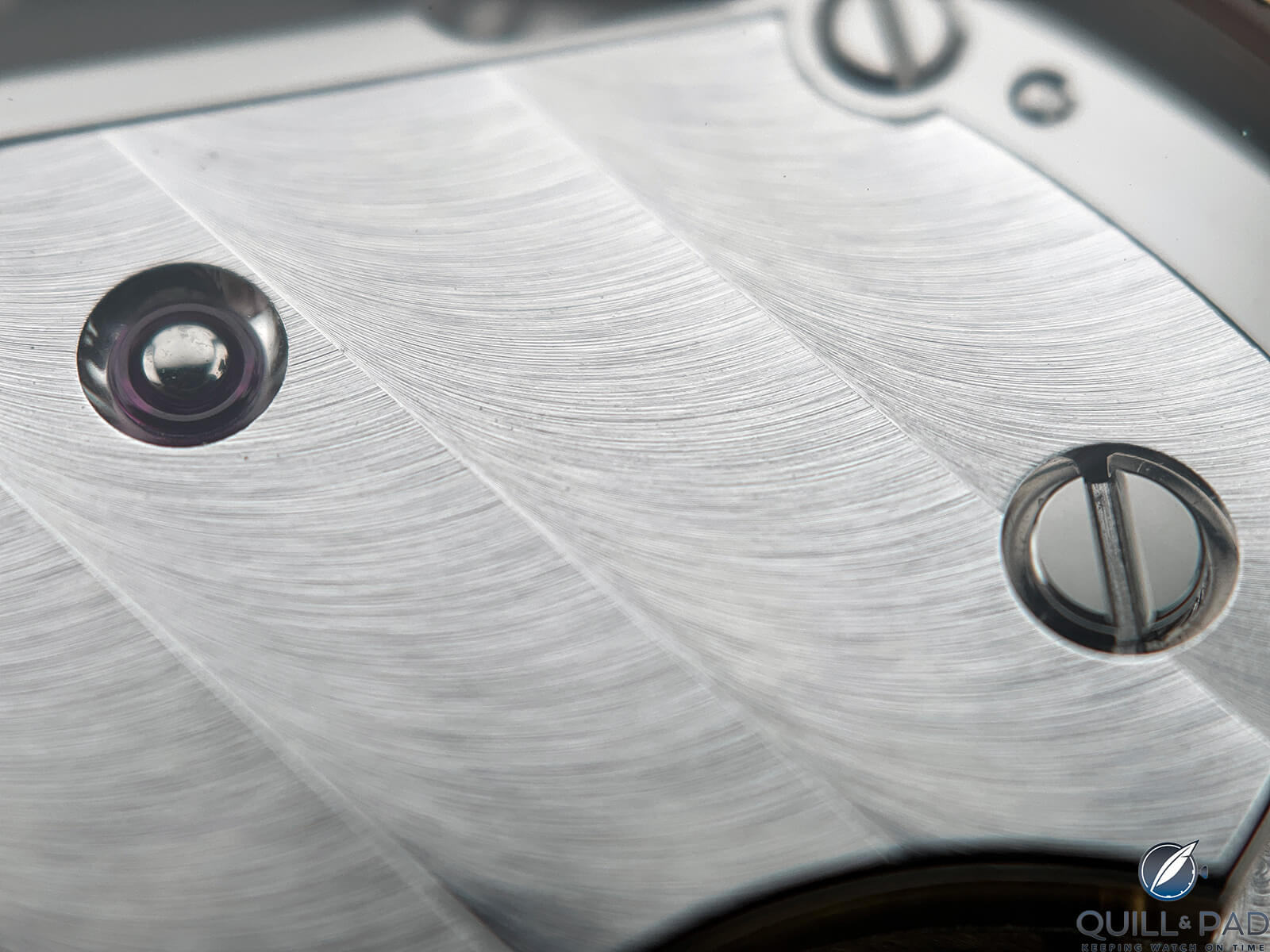
Geneva waves on the Philippe Dufour Simplicity: note that the plate is actually flat, the waves are an optical illusion (photo by Tim Mosso)
Dufour’s work on the Simplicity has another quality that I’ve rarely experienced with Geneva waves; the illusion of depth. Each one looks like a wind-driven wave on the open ocean with a crest, trough, and foam. Shifting light over the surface of these bridges completes the trompe-l’œil of this ironic nameless caliber.
Philippe Dufour sometimes cuts the figure of a traditionalist. For example, he is the only person I’ve ever met who still smokes a pipe. But then he shows up at events in vivid red and neon pink suits – or he agrees to an interview with a YouTuber like me – and I’m forced to re-assess.
This carries over to his watchmaking. Dufour is open to the use of computer design software for basic development. He has no qualms about relying on mechanized technologies like electro-spark erosion to cut raw components for his watches. And unlike an endless catalog of lesser creators, Dufour is open about using third-party suppliers for specialized components.
The movement of the Simplicity reflects the – small “d” – duality of Dufour’s approach to watchmaking. His traditional bridge anglage is the stuff of legend, and it doesn’t disappoint.
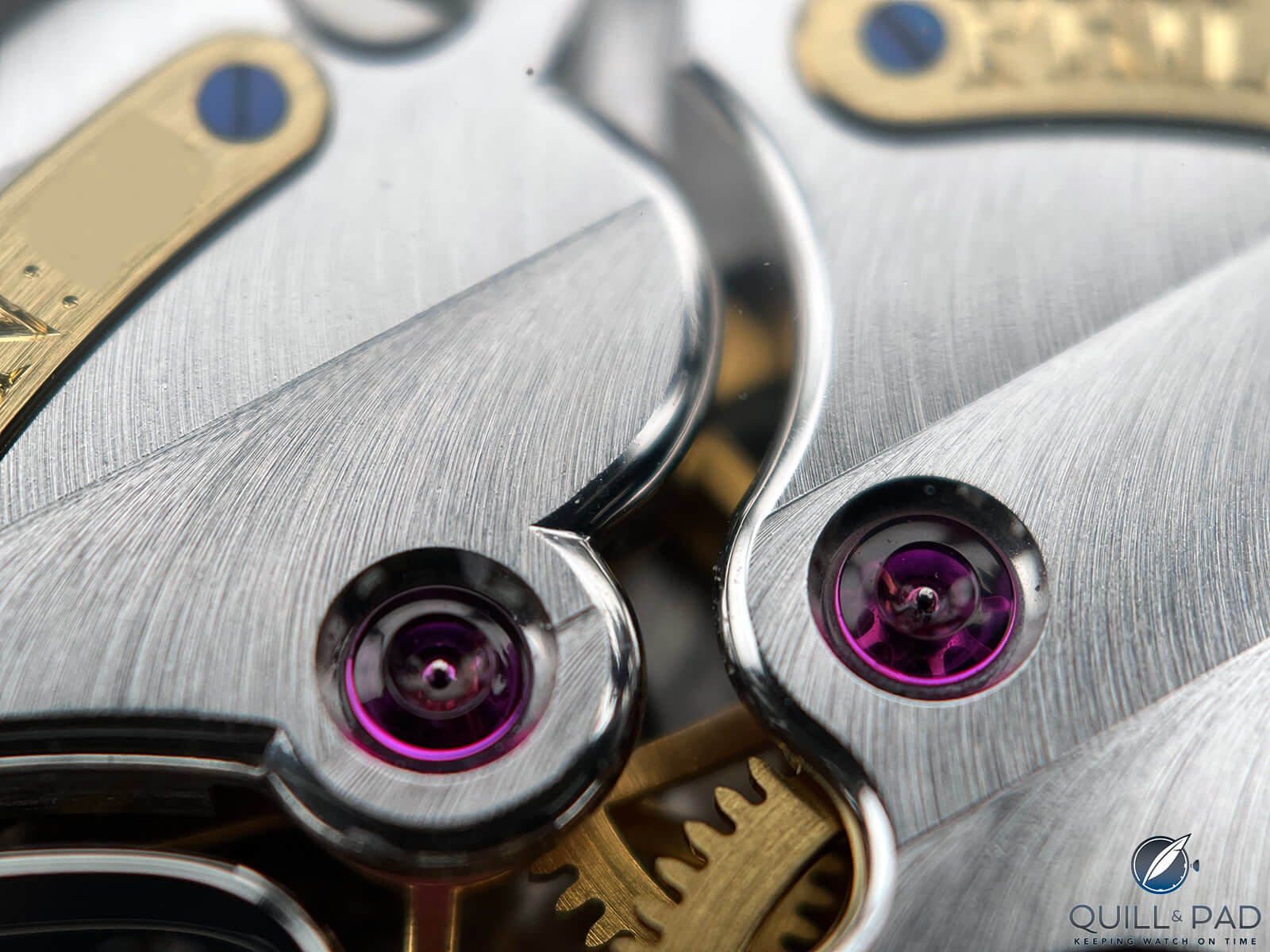
Philippe Dufour Simplicity (photo by Tim Mosso)
These bevels are broad, round, and finished on the final pass with gentian wood harvested locally in Dufour’s native Vallée de Joux. The expansive, gleaming result creates the impression that these bridges are dramatically thicker than standard, and the excitement continues where bevels meet. “Interior” angles where bevels converge are sharp and evenly drawn into perfect vertical creases.
Dufour even provides one on the hard-to-work steel cap of the escape wheel cock adjacent to the balance. Exterior angles where bevels meet as a sharp edge are equally compelling, and the pointed “horns” over the center wheel are a signature flourish on Dufour watches dating back to his pocket watch sonnerie era.
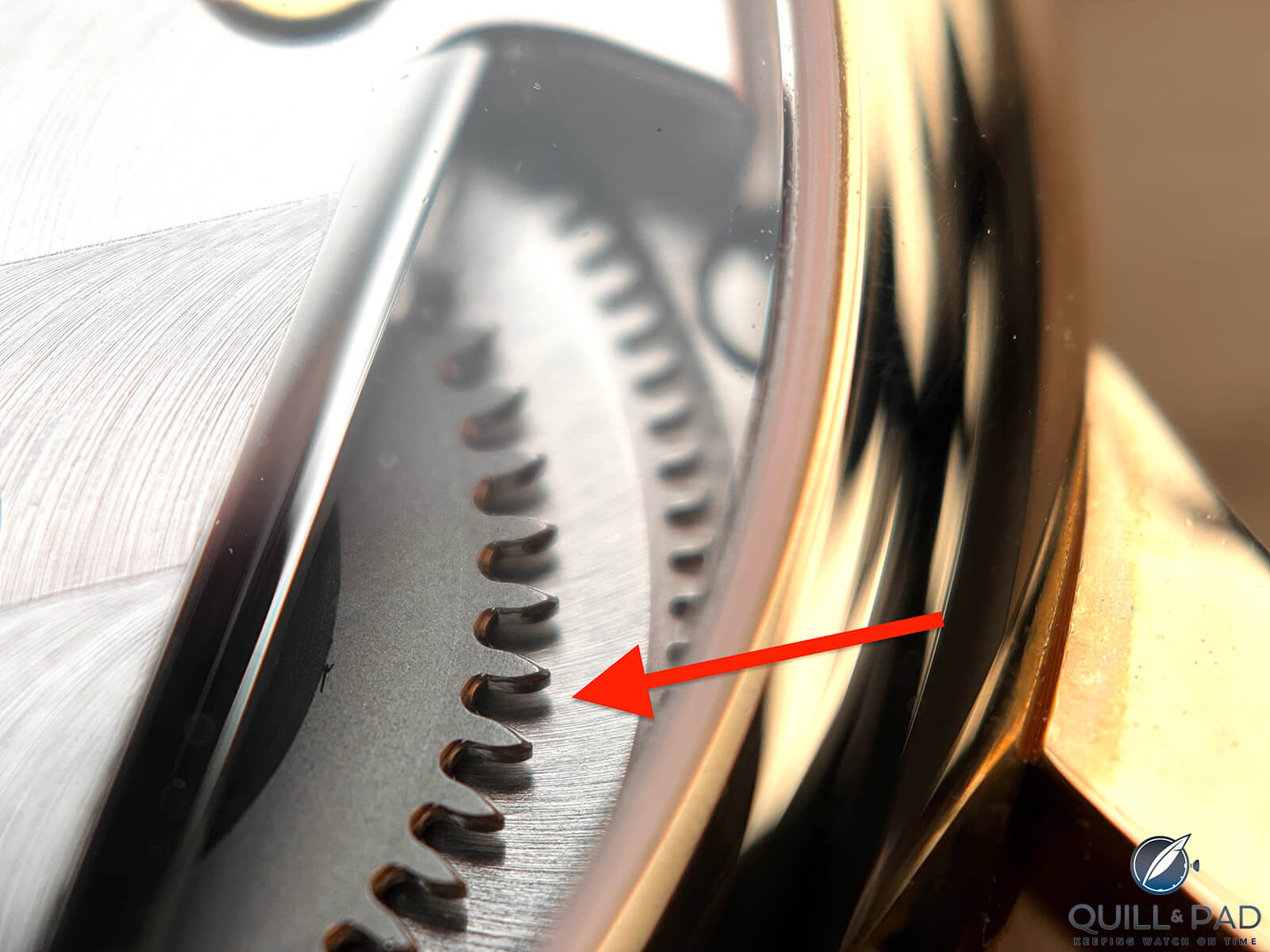
Philippe Dufour Simplicity (photo by Tim Mosso)
But Dufour confounds with his use of a fixed stud holder and a modern free-sprung balance. This type of arrangement is becoming a standard on contemporary watches after spending decades as system championed mostly by Rolex and Patek Philippe. Adjustments to the timing of the watch are accomplished by turning masses on the balance that alter its “moment,” or turning force.

Balance wheel and regulating screws of the Philippe Dufour Simplicity (photo by Tim Mosso)
The Simplicity clearly sports this precise and shock-resistant free-sprung architecture because Dufour accepted its superiority over its archaic predecessors.
A slow 2.5Hz beat rate and a blued Breguet overcoil hairspring likely made the cut, not because Dufour’s a sentimental type, but because they still perform.
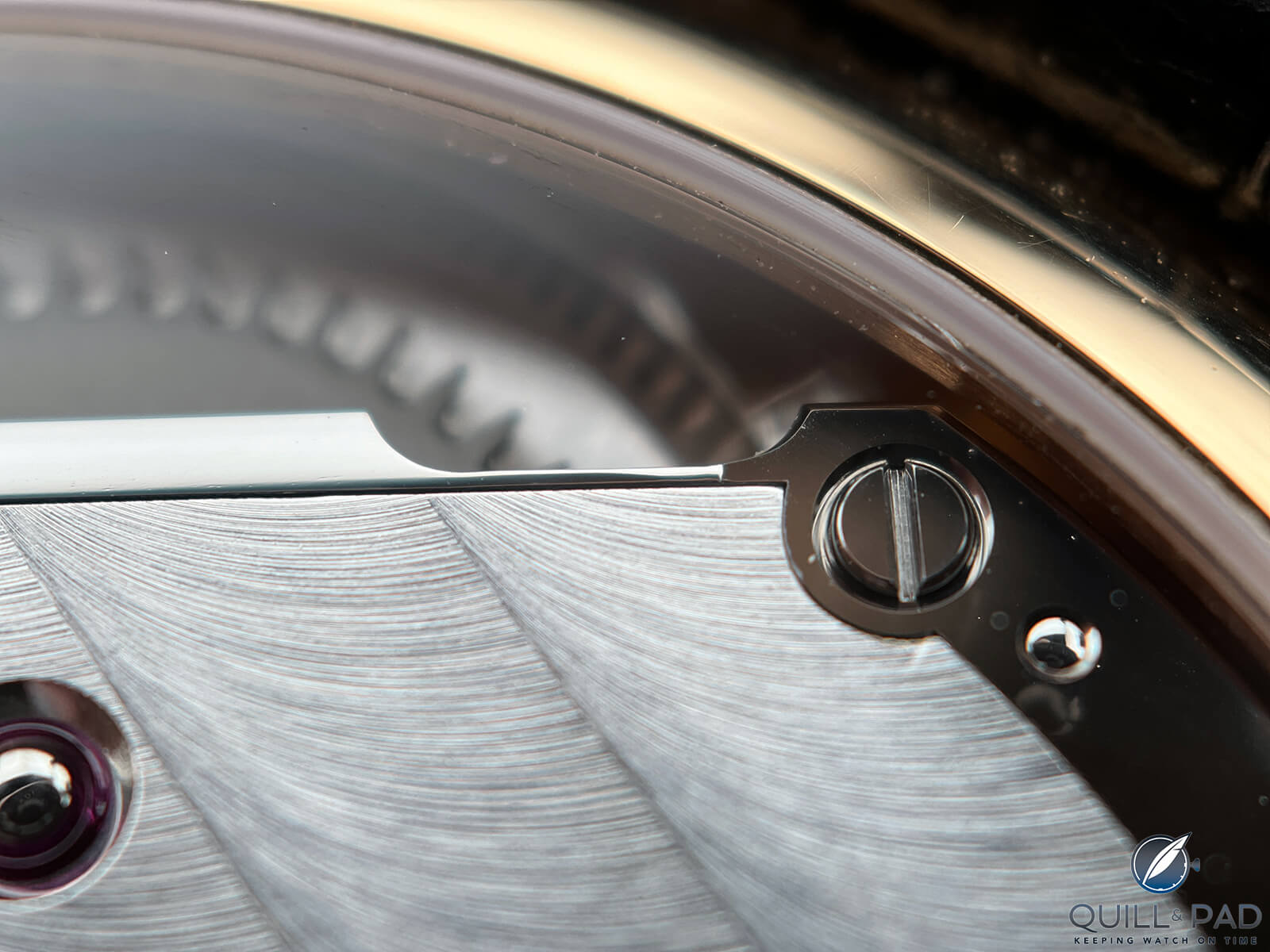
Philippe Dufour Simplicity (photo by Tim Mosso)
Screws can tell an observer a great deal about the quality of a watch. At one end of the scale, there are low-cost hardware store refugees that would look at home on an electric shaver. At the other end, you have what Dufour uses. Each of these screws has a micro-profiled slot likely formed with a triangular ruby file and patience.
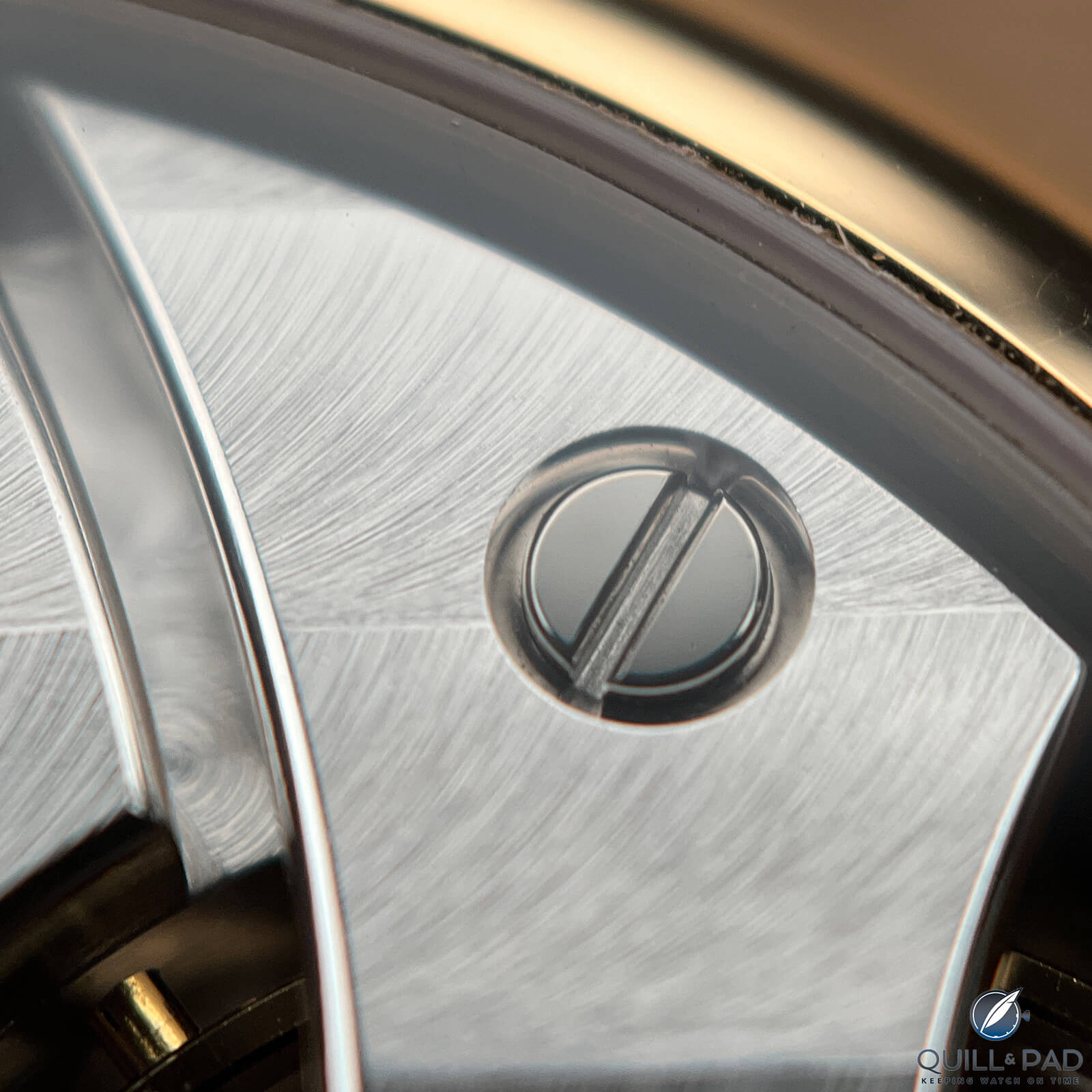
Polished chamfered screw head of the Philippe Dufour Simplicity (photo by Tim Mosso)
Like most elements of fine watch finish, this technique has a functional root; it helps to slot the screwdriver and avoid slipping from the head of the screw. Additional chamfers encircle the outside of the screw head. Finally, “black” polish that reflects light at a certain angle is applied either with lapping paper or a zinc plate.
This optically smooth “poli noir” is generally applied only to steel parts of a movement. On the Simplicity, Dufour graces most of the screws, the escape wheel cock cover, and the click spring with this treatment.
The click design, which incorporates both the click spring and the actual pawl in single unit, is drawn from antiquity.
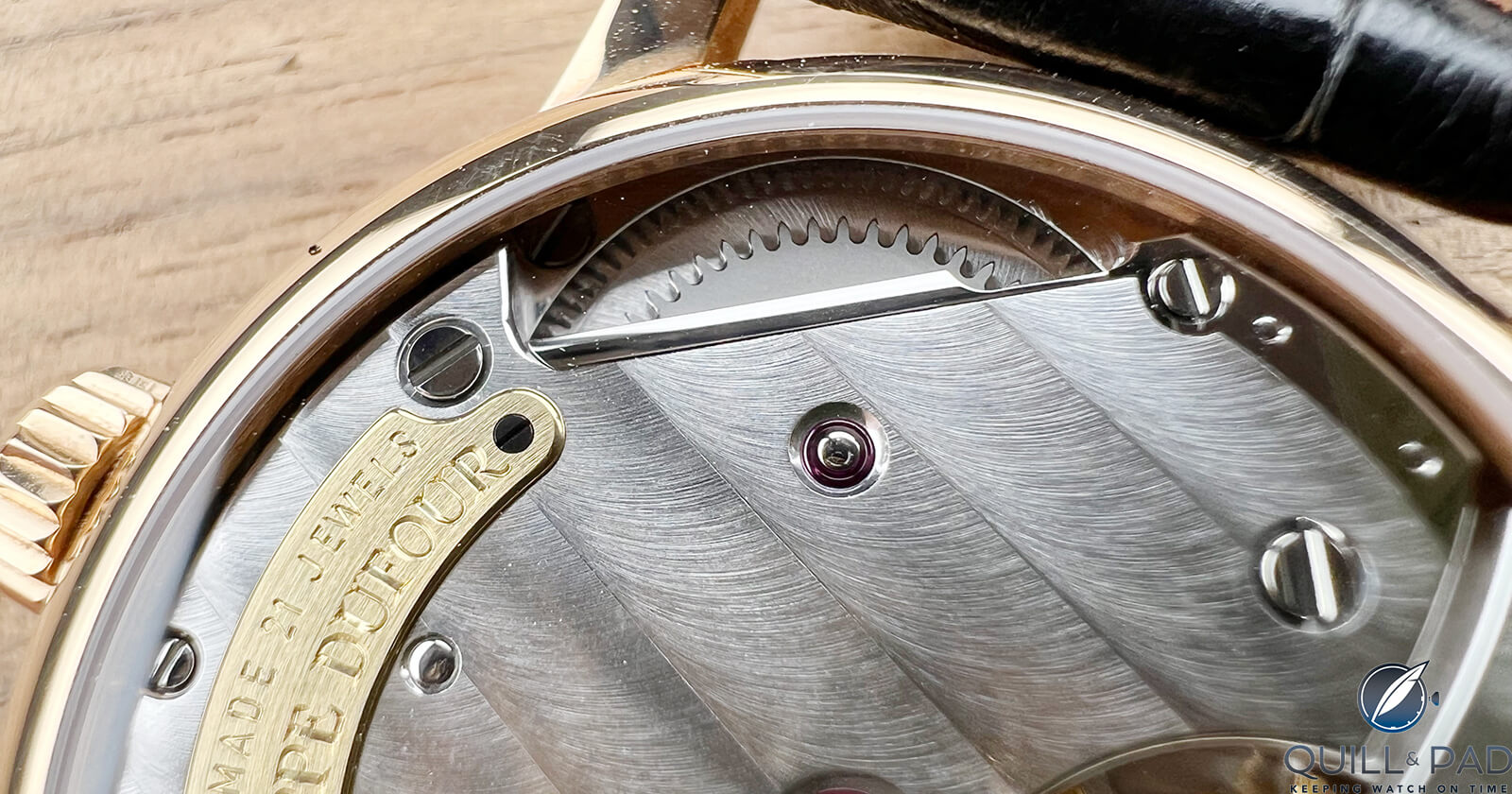
Blade click at the top of the movement on the Philippe Dufour Simplicity (photo by Tim Mosso)
But this old-fashioned component begins its transformation from raw metal via a computer-assisted process that Dufour has embraced. Once again, the master is full of surprises. Once cut, the raw component relies on human hands to achieve artisanal status.
While most of the screws on the Simplicity are polished steel, Dufour reserves four fire-blued screws for a special assignment. A completed Simplicity features two hand-engraved plaques: one for the serial number and one for the maker’s mark.
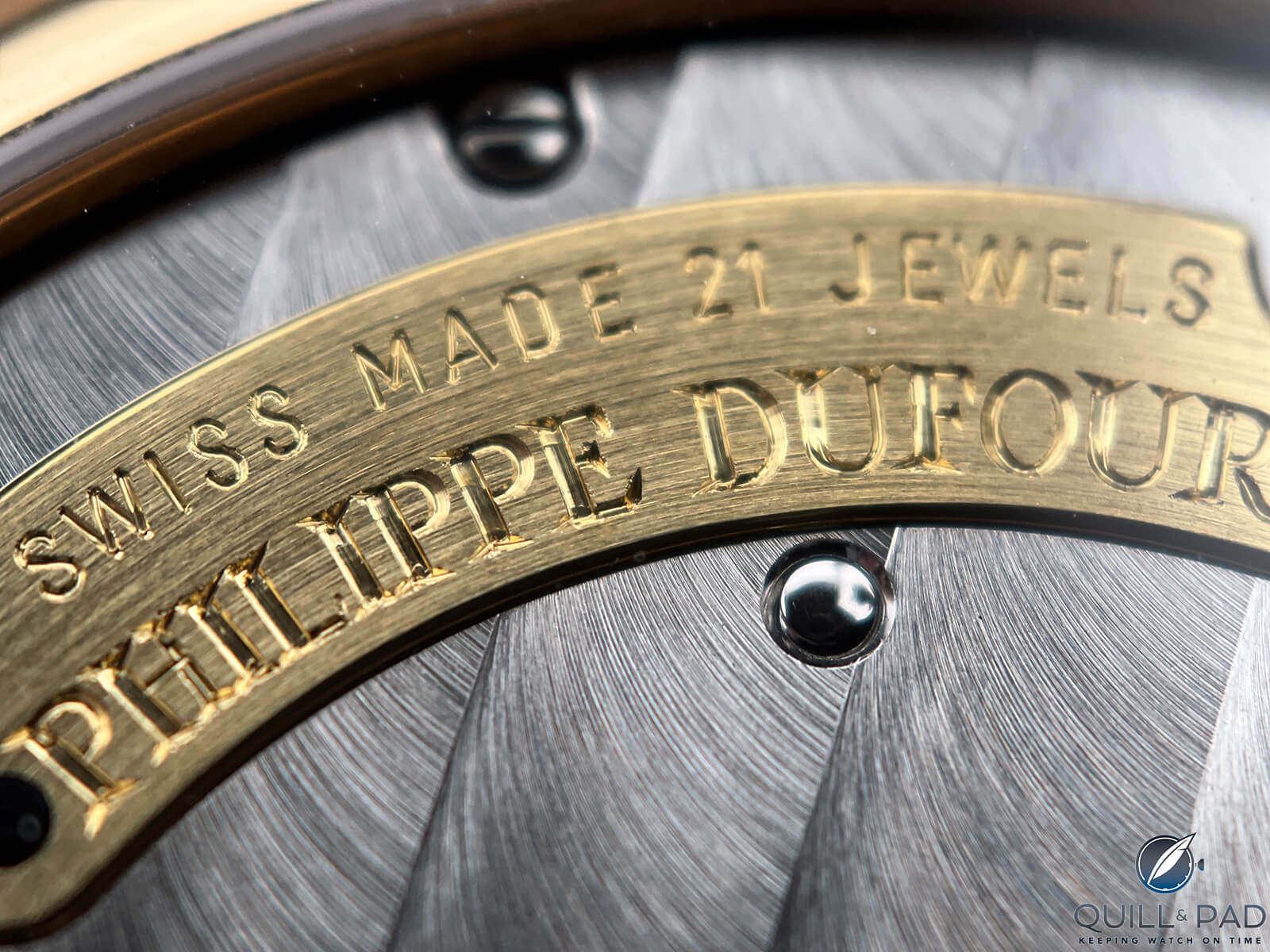
Philippe Dufour Simplicity (photo by Tim Mosso)
The tonal contrast between bright gold and dark blue steel is exquisite. As for the engraved plates, they are beautifully imperfect. To the naked eye, the chiseled characters look as perfect as if they had been traced by a drill bit. But high magnification reveals the telltale wander of hand tools and the presence of a gifted human hand.
More surprises arise when comparing the movement’s size to that of its container. From a caseback vantage point, it’s almost shocking to realize that Dufour has packed a 30mm movement into a 34mm case. Given its late 90s gestation, the dimensions of the movement are shockingly contemporary. The power reserve also deserves mention because the 52-hour run time is remarkable for a 34mm watch.
By comparison, Jaeger-LeCoultre’s identically sized 1990s Master Ultra-Thin 34 houses a 20.2mm movement with a 35-hour power reserve.
Externally, the Simplicity lives up to its name. The case is conservative, round, and defined by strong lug profiles. The lugs are of the “welded” variety that defy easy replication by stamping or machining techniques.
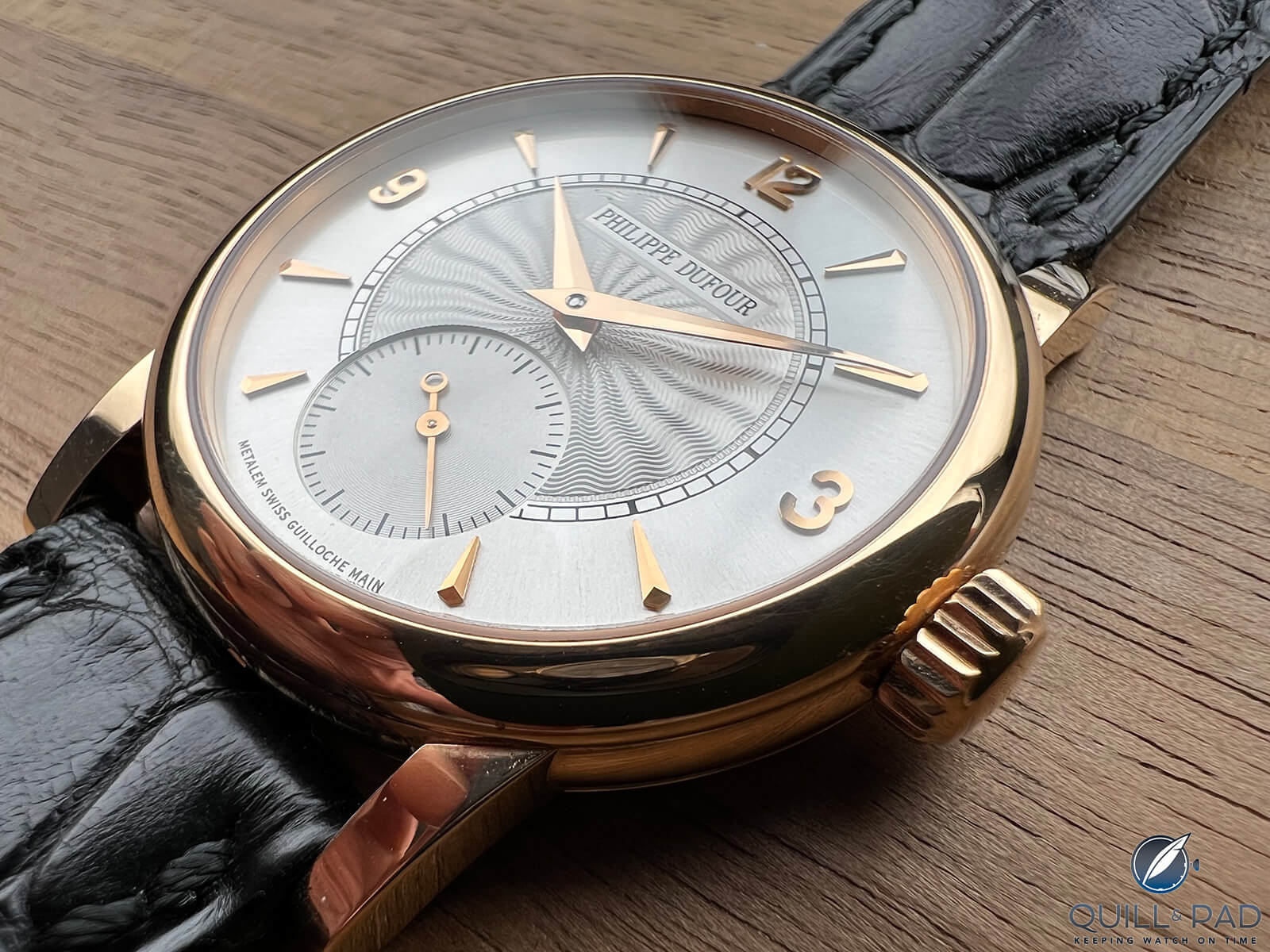
Philippe Dufour Simplicity (photo by Tim Mosso)
Lugs are created separate from the case, the two are welded together, and the residual “clag” from the welded joint is removed by hand to create a dramatic crease between the surfaces.
A vintage-inspired unsigned crown completes the mid-century throwback ambiance of this late-twentieth-century design.
While the Simplicity has been built in several metals and dial configurations, most feature a dial by supplier Metalem in enamel or engine-turned metal.
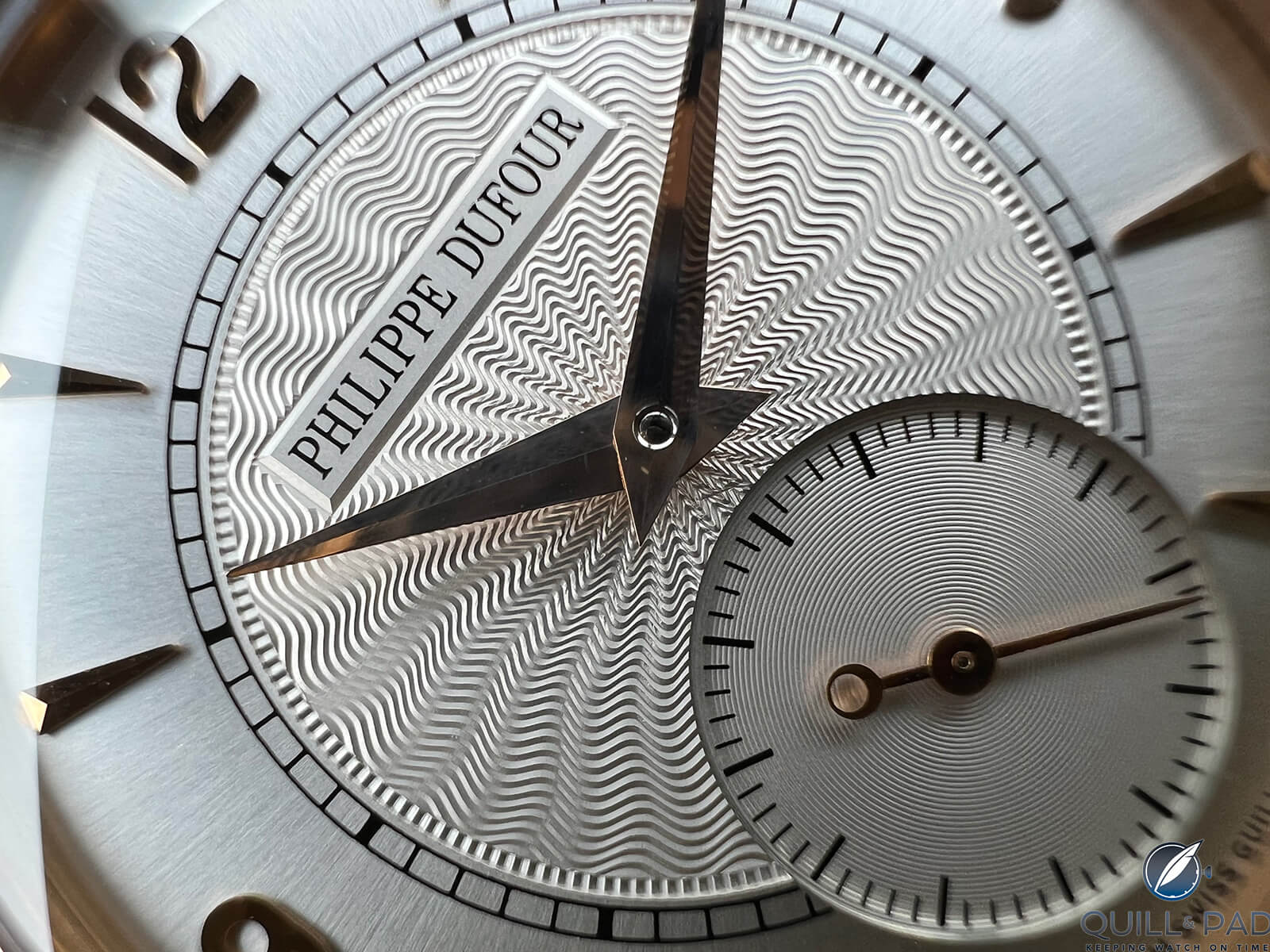
Philippe Dufour Simplicity (photo by Tim Mosso)
The particular example shown includes what might be described as the model’s “classic” look with tri-Arabic numerals, dart-style indices, dauphine hands, and a lathe-cut guilloché radiating out from the center.
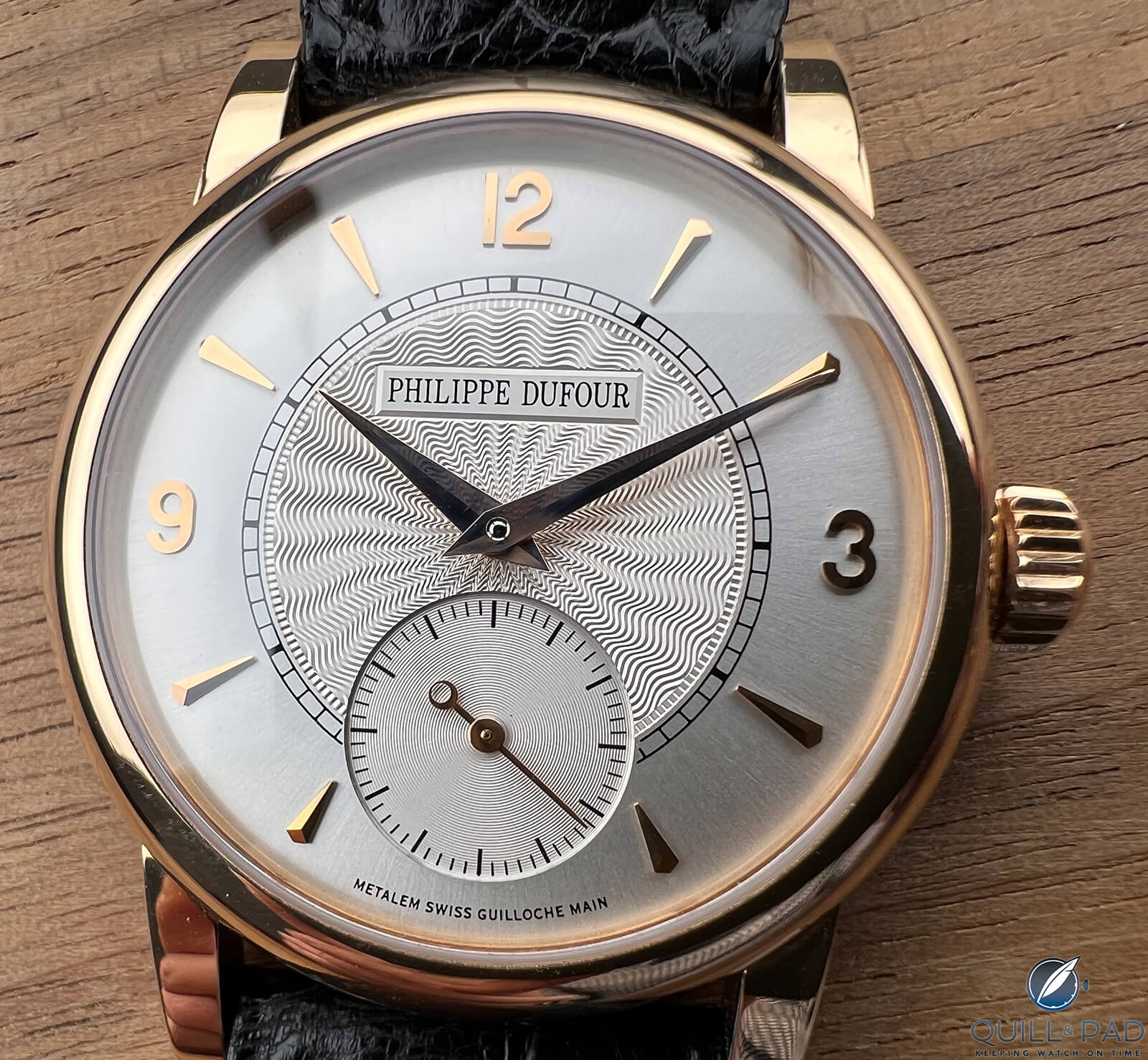
Philippe Dufour Simplicity (photo by Tim Mosso)
Dufour’s willingness to put the supplier’s name on the bottom of the dial is a masterclass in humility and sharing credit.
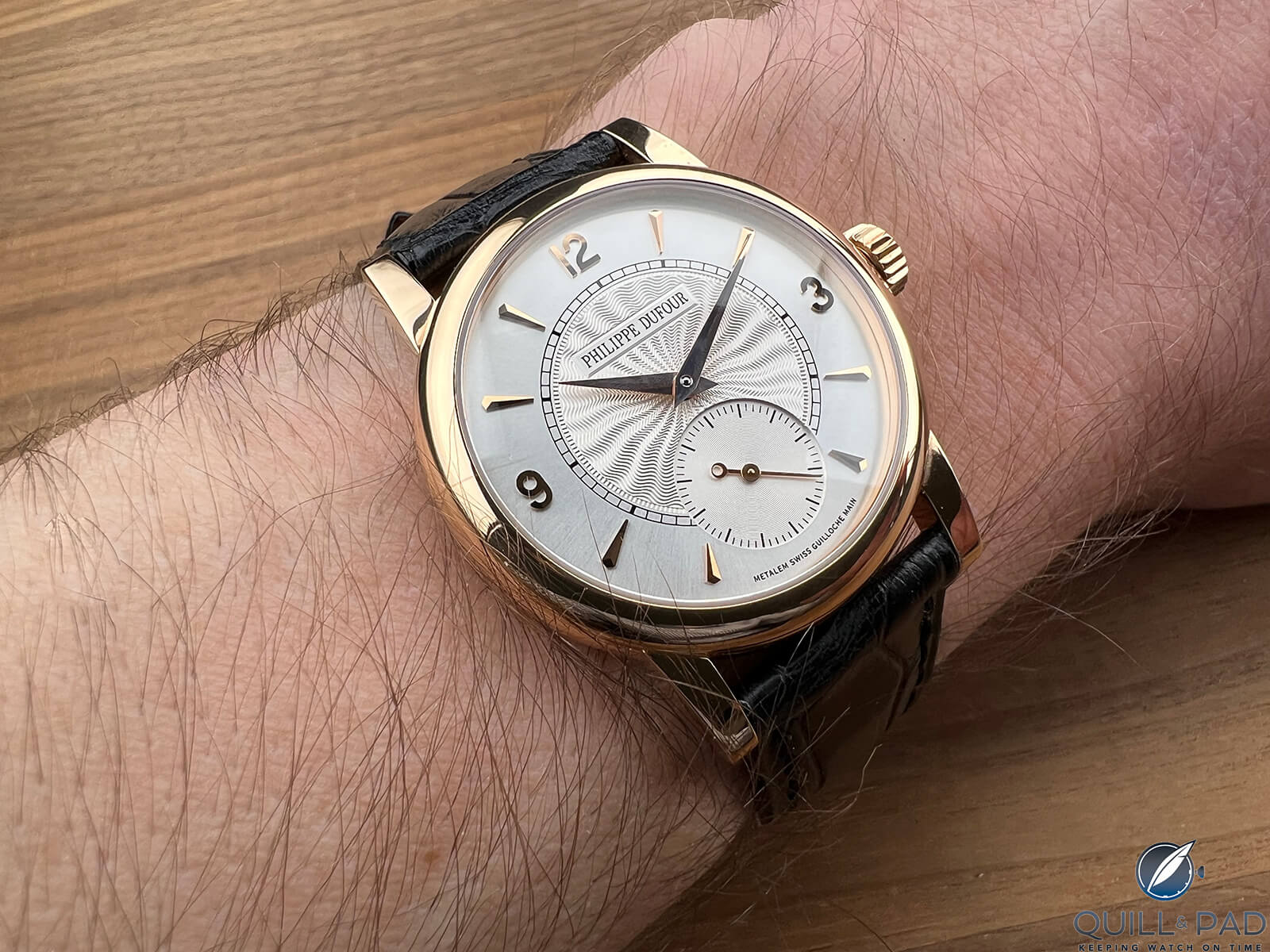
Philippe Dufour Simplicity (photo by Tim Mosso)
I’ve always put more stock in character than appearance, and I like to say that “the man makes the watch.” While it’s fun to wear and share our favorite timepieces, we’re not the things we own. But Philippe Dufour adds new meaning to my maxim. He’s literally the man who makes the watch. As an uncommon blend of warmth and candor, Dufour is as brilliant as his machine.
For more information, please visit https://philippedufour.ch/
Quick Facts: Philippe Dufour Simplicity
Production period: 2000-2021
Functions: hours, minutes, seconds
Case: rose gold, other metals offered;
Dimensions: 34mm x 8.4mm x 40.5mm, 37mm diameter optional
Water resistance: 30 meters
Dial: silver guilloche with rose hands, numerals, and indices by Metalem
Movement: Dufour manual wind, 52-hour power reserve, 21 jewels, 2.5Hz, free spring, Breguet overcoil hairspring, 30mm diameter
Market Value 2023: $650,000 (model shown)
* Tim Mosso is the media director and watch specialist at Watchbox. You can check out his very comprehensive YouTube channel at www.youtube.com/@WatchBoxStudios/videos
You might also enjoy:
Why Philippe Dufour Matters. And It’s Not A Secret
Philippe Dufour Simplicity Deconstructed By The Naked Watchmaker
Behind The Lens: The Philippe Dufour Simplicity
Behind The Lens: Philippe Dufour Duality
Philippe Dufour 70th Birthday Celebration Film
‘Time Piece’: If You Only Watch One Film On Independent Watchmaking, Watch This One
‘Making Time’ Film: A Cinephile Review By A Watch Lover
Leave a Reply
Want to join the discussion?Feel free to contribute!



Tim,
Thank you for making accessible the unobtainable!
Cheers!